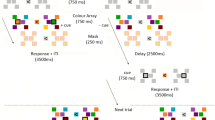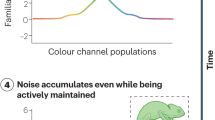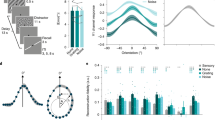Abstract
At any instant, our visual system allows us to perceive a rich and detailed visual world. Yet our internal, explicit representation of this visual world is extremely sparse: we can only hold in mind a minute fraction of the visual scene1,2. These mental representations are stored in visual short-term memory (VSTM). Even though VSTM is essential for the execution of a wide array of perceptual and cognitive functions3,4,5, and is supported by an extensive network of brain regions6,7,8,9, its storage capacity is severely limited10,11,12,13. With the use of functional magnetic resonance imaging, we show here that this capacity limit is neurally reflected in one node of this network: activity in the posterior parietal cortex is tightly correlated with the limited amount of scene information that can be stored in VSTM. These results suggest that the posterior parietal cortex is a key neural locus of our impoverished mental representation of the visual world.
This is a preview of subscription content, access via your institution
Access options
Subscribe to this journal
Receive 51 print issues and online access
$199.00 per year
only $3.90 per issue
Buy this article
- Purchase on Springer Link
- Instant access to full article PDF
Prices may be subject to local taxes which are calculated during checkout




Similar content being viewed by others
References
Rensink, R. A. Change detection. Annu. Rev. Psychol. 53, 245–277 (2002)
Simons, D. & Levin, D. Change blindness. Trends Cogn. Sci. 1, 261–267 (1997)
Chun, M. M. & Potter, M. C. A two-stage model for multiple target detection in rapid serial visual presentation. J. Exp. Psychol. Hum. Percept. Perform. 21, 109–127 (1995)
Jolicoeur, P., Dell' Acqua, R. & Crebolder, J. M. in The Limits of Attention: Temporal Constraints in Human Information Processing (ed. Shapiro, K.) 82–99 (Oxford Univ. Press, 2001)
Wheeler, M. E. & Treisman, A. M. Binding in short-term visual memory. J. Exp. Psychol. Gen. 131, 48–64 (2002)
Goldman-Rakic, P. S. in Handbook of Physiology: The Nervous System, Higher Functions of the Brain (eds Mountcastle, V. B. & Plum, F.) 373–417 (American Physiological Society, Bethesda, Maryland, 1987)
Ungerleider, L. G., Courtney, S. M. & Haxby, J. V. A neural system for human visual working memory. Proc. Natl Acad. Sci. USA 95, 883–890 (1998)
Callicott, J. H. et al. Physiological characteristics of capacity constraints in working memory as revealed by functional MRI. Cereb. Cortex 9, 20–26 (1999)
Linden, D. E. et al. Cortical capacity constraints for visual working memory: Dissociation of fMRI load effects in a fronto-parietal network. Neuroimage 20, 1518–1530 (2003)
Duncan, J. et al. Systematic analysis of deficits in visual attention. J. Exp. Psychol. Gen. 128, 450–478 (1999)
Cowan, N. The magical number 4 in short-term memory: A reconsideration of mental storage capacity. Behav. Brain Sci. 24, 87–114 (2001)
Pashler, H. Familiarity and visual change detection. Percept. Psychophys. 44, 369–378 (1988)
Vogel, E. K., Woodman, G. F. & Luck, S. J. Storage of features, conjunctions and objects in visual working memory. J. Exp. Psychol. Hum. Percept. Perform. 27, 92–114 (2001)
Cohen, J. D. et al. Temporal dynamics of brain activation during a working memory task. Nature 386, 604–608 (1997)
Phillips, W. A. On the distinction between sensory storage and short-term visual memory. Percept. Psychophys. 16, 283–290 (1974)
Coltheart, M. in New Horizons in Psychology (ed. Dodwell, P. C.) 62–85 (Harmondsworth, Penguin, 1972)
Baddeley, A. Working memory. Science 255, 556–559 (1992)
Smith, E. E. & Jonides, J. Neuroimaging analyses of human working memory. Proc. Natl Acad. Sci. USA 95, 12061–12068 (1998)
Rosnow, R. L. & Rosenthal, R. Contrasts and interactions redux: Five easy pieces. Psychol. Sci. 7, 253–257 (1996)
Courtney, S. M., Ungerleider, L. G., Keil, K. & Haxby, J. V. Transient and sustained activity in a distributed neural system for human working memory. Nature 386, 608–611 (1997)
Pessoa, K., Gutierrez, E., Bandettini, P. A. & Ungerleider, L. G. Neural correlates of visual working memory: fMRI amplitude predicts task performance. Neuron 35, 975–987 (2002)
Zarahn, E., Aguirre, G. & D'Esposito, M. A trial-based experimental design for fMRI. Neuroimage 6, 122–138 (1997)
Friedman-Hill, S. R., Robertson, L. C. & Treisman, A. Parietal contributions to visual feature binding: Evidence from a patient with bilateral lesions. Science 269, 853–855 (1995)
Shafritz, K. M., Gore, J. C. & Marois, R. The role of the parietal cortex in visual feature binding. Proc. Natl Acad. Sci. USA 99, 10917–10922 (2002)
Haxby, J. V. et al. Dissociation of object and spatial visual processing pathways in human extrastriate cortex. Proc. Natl Acad. Sci. USA 88, 1621–1625 (1991)
McKeefry, D. J. & Zeki, S. The position and topography of the human colour centre as revealed by functional magnetic resonance imaging. Brain 120, 2229–2242 (1997)
Curtis, C. E. & D'Esposito, M. Persistent activity in the prefrontal cortex during working memory. Trends Cogn. Sci. 7, 415–423 (2003)
Beck, D. M., Rees, G., Frith, C. D. & Lavie, N. Neural correlates of change detection and change blindness. Nature Neurosci. 4, 645–650 (2001)
Gottlieb, J. P., Kusunoki, M. & Goldberg, M. E. The representation of visual salience in monkey parietal cortex. Nature 391, 481–484 (1998)
Kourtzi, Z. & Kanwisher, N. Representation of perceived object shape by the human lateral occipital complex. Science 293, 1506–1509 (2001)
Acknowledgements
We thank I. Gauthier, M. Chun, G. Logan and J. Schall for comments on earlier versions of this manuscript, and D. Nikolaiczyk-Stocks and A. Snyder for expert technical assistance. This work was supported by a grant from the NSF to R.M.
Author information
Authors and Affiliations
Corresponding author
Ethics declarations
Competing interests
The authors declare that they have no competing financial interests.
Rights and permissions
About this article
Cite this article
Todd, J., Marois, R. Capacity limit of visual short-term memory in human posterior parietal cortex. Nature 428, 751–754 (2004). https://doi.org/10.1038/nature02466
Received:
Accepted:
Issue Date:
DOI: https://doi.org/10.1038/nature02466
This article is cited by
-
Diminished activation of excitatory neurons in the prelimbic cortex leads to impaired working memory capacity in mice
BMC Biology (2023)
-
Stunting in infancy is associated with atypical activation of working memory and attention networks
Nature Human Behaviour (2023)
-
Visual stimulation by extensive visual media consumption can be beneficial for motor learning
Scientific Reports (2023)
-
Developing Artificial Human-Like Arithmetical Intelligence (and Why)
Minds and Machines (2023)
-
Hand constraint reduces brain activity and affects the speed of verbal responses on semantic tasks
Scientific Reports (2022)
Comments
By submitting a comment you agree to abide by our Terms and Community Guidelines. If you find something abusive or that does not comply with our terms or guidelines please flag it as inappropriate.



